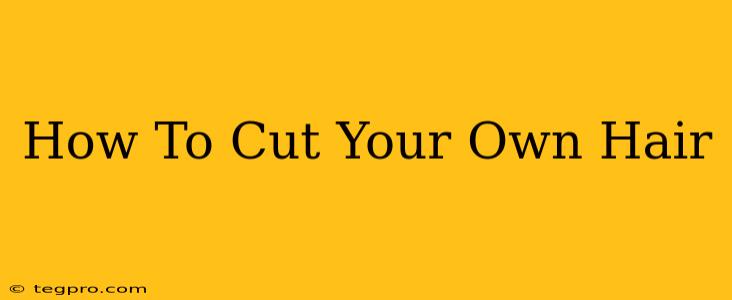Cutting your own hair might seem daunting, but with the right tools and techniques, you can achieve surprisingly good results, saving money and the hassle of salon appointments. This guide provides a step-by-step process for various haircuts, focusing on safety and achieving a polished look.
Preparing for Your DIY Haircut
Before you grab those scissors, preparation is key. This ensures a smoother, safer, and more successful haircut.
Gather Your Supplies:
- Sharp Hair Cutting Scissors: Using dull scissors will lead to uneven cuts and split ends. Invest in a pair specifically designed for hair.
- Hair Clips: These are essential for sectioning your hair.
- Comb: A wide-tooth comb is ideal for detangling and sectioning.
- Spray Bottle: Keep a spray bottle filled with water handy to dampen your hair as needed. This makes it easier to manage and cut.
- Mirror: You'll need at least one large mirror, and ideally a smaller hand mirror for viewing the back of your head.
- Optional: Hair Cutting Shears (Thinning Shears): These are useful for blending and softening harsh lines, but not essential for beginners.
Prepare Your Hair:
- Wash and Condition: Start with clean, dry hair. This allows you to see the hair's natural texture and prevents unexpected surprises. For very thick or curly hair, consider washing the day before to let the hair settle.
- Detangle Thoroughly: Use your wide-tooth comb to remove any knots or tangles.
- Section Your Hair: This is crucial for even cuts. Use clips to divide your hair into manageable sections.
Different Haircut Techniques for Beginners
The best technique depends on the style you're aiming for. We'll cover some basic approaches:
Trimming Your Layers (Long Hair):
- Start with Small Sections: Begin with a small section at the front of your hair, holding it taut between your fingers.
- Point Cut: Instead of cutting straight across, point-cut your hair by snipping into the ends at an angle. This creates a softer, less blunt finish. Only cut what you see. Aim for tiny snips.
- Work Your Way Around: Gradually work your way around your head, section by section, maintaining the same length and angle for consistency.
Blunt Cut (Short to Medium Length Hair):
- Even Sections: Make sure your sections are perfectly even before cutting.
- Straight Cut: Use your comb to guide your scissors, making a straight, horizontal cut.
- Check for Evenness: Frequently use your mirrors to check for evenness and correct any discrepancies.
Bang Trim:
- Small Sections: Trim bangs in very small sections.
- Dry Cut: It's easier to see the shape of your bangs when they are dry.
- Comb Down: Use a comb to create a straight line across your forehead, then cut the ends to your desired length.
Tips for Success
- Take Your Time: Rushing will lead to mistakes.
- Start Small: It's better to cut less hair than too much. You can always trim more later.
- Use Sharp Scissors: Dull scissors will create uneven, frayed ends.
- Watch Tutorials: Many online tutorials demonstrate various haircut techniques, visualize the process.
- Practice Makes Perfect: Don't get discouraged if your first attempt isn't perfect. Practice will improve your skills over time.
When to Seek Professional Help
While cutting your own hair can be a rewarding experience, some situations warrant seeking a professional hairstylist:
- Significant Changes: If you're planning a dramatic haircut or a complex style.
- Difficult Hair Textures: Very thick, curly, or textured hair is challenging to cut at home.
- Unsatisfactory Results: If you're unhappy with your attempts, a stylist can rectify the situation.
Cutting your own hair is a skill that develops over time. Be patient, practice regularly, and remember that even minor improvements are a win. With the right approach, you can enjoy a stylish, affordable haircut from the comfort of your own home.

